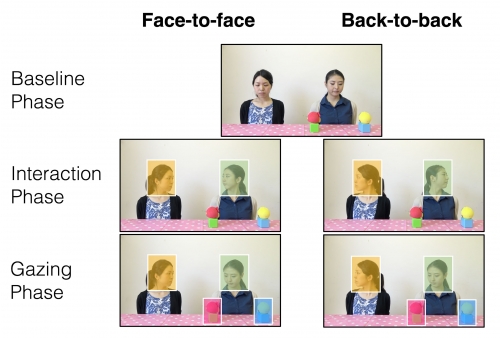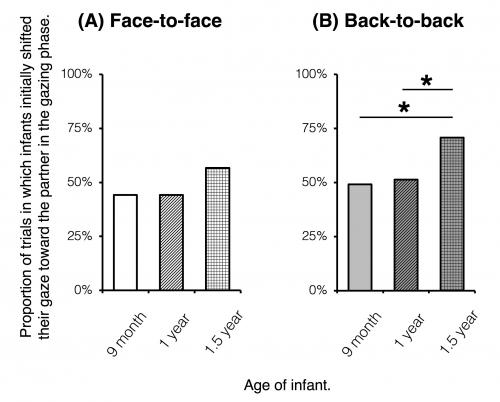研究成果 Research Results
- TOP
- News
- Research Results
- Spontaneous concern with the epistemic gap between others in 1.5-year-old infants
Spontaneous concern with the epistemic gap between others in 1.5-year-old infants
2017.02.08Research ResultsHumanities & Social SciencesLife & Health
Not only responding to direct social actions toward themselves, infants also pay attention to relevant information from third-party interactions ; for example, they learn new words from observing conversations of the others. However, it is unclear whether and how infants recognize the structure of these interactions. The current study aimed to investigate infants’ observation of third-party attentional relationships and whether they influence the infants’ subsequent gaze following (a reflexive tendency to follow others’ gaze, considered to be essential to learning and social interactions). Nine-month-old, 1-year-old, and 1.5-year-old infants (N = 72, 37 girls) observed video clips in which a female actor gazed at one of two toys after she and her partner either silently faced each other (face-to-face condition) or looked in opposite directions (back-to-back condition). An eye tracker was used to record the infants’ looking behavior (e.g., looking time, looking frequency). The analyses revealed that younger infants followed the actor’s gaze toward the target object in both conditions, but this was not the case for the 1.5-year-old infants in the back-to-back condition. Furthermore, we found that infants’ gaze following could be negatively predicted by their expectation of the partner’s response to the actor’s head turn (i.e., they shift their gaze toward the partner immediately after they realize that the actor’s head will turn). These findings suggested that the sensitivity to the difference in knowledge and attentional states in the second year of human life could be extended to third-party interactions, even without any direct involvement in the situation. Additionally, a spontaneous concern with the epistemic gap between self and other, as well as between others, develops by this age. These processes might be considered part of the fundamental basis for human communication.

Fig. 1. Samples of the experimental stimuli presented in the face-to-face and back-to-back conditions across the three phases. Colored rectangular areas indicate the areas of interest for analysis.

Fig. 2. The results of the gaze shifts toward the partner in the face-to-face (A) and back-to-back (B) conditions. The proportion was calculated by dividing the number of trials with a first gaze saccade to the partner by the total number of trials with a gaze saccade to either the partner or objects (*adj. p < .05).
Journal Reference
Observing Third-Party Attentional Relationships Affects Infants' Gaze Following: An Eye-Tracking Study, ,Frontiers in Psychology, 10.3389/fpsyg.2016.02065Research-related inquiries
- TOP
- News
- Research Results
- Spontaneous concern with the epistemic gap between others in 1.5-year-old infants































